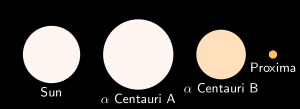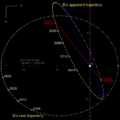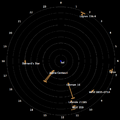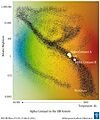Alpha Centauri facts for kids
Alpha Centauri is the brightest star you can see in the southern Centaurus constellation. It's actually the fourth brightest star in the whole night sky! You can easily spot it if you live in the Southern Hemisphere. But if you're in most parts of the Northern Hemisphere, it's too far south to see.
Alpha Centauri isn't just one star. It's a binary star system, meaning it has two main stars, called Alpha Centauri A and Alpha Centauri B. They are very close to each other, so close that your naked eye can't tell them apart. These two stars orbit each other at a distance similar to how far the giant planets are from our Sun.
There's also a third star, called Proxima Centauri (or Alpha Centauri C). Even though it's often talked about separately, it's actually connected by gravity to Alpha Centauri A and B. Proxima Centauri is a tiny bit closer to Earth than A and B, and it has a much, much bigger orbit around them.
The Alpha Centauri Star System
Alpha Centauri is the closest star system to our own Sun. It's about 4.2 to 4.4 light years away. A light-year is the distance light travels in one year, which is a very long way!
This system has three stars:
- Alpha Centauri A and Alpha Centauri B are the two main stars that form a binary star pair. They are about 4.36 light-years from us.
- Proxima Centauri is a dimmer red dwarf star. It's actually the closest star to Earth, at about 4.22 light-years away.
Both Alpha Centauri A and B are quite similar to our Sun. Alpha Centauri A is the most like the Sun, but it's a little bigger and brighter.
- The next closest star after the Alpha Centauri system is Barnard's Star.
See Also
 In Spanish: Alfa Centauri para niños
In Spanish: Alfa Centauri para niños
Images for kids
-
The Apparent and True Orbits of Alpha Centauri.
The Apparent Orbit (thin ellipse) is the shape of the orbit as seen by the observer on Earth. The True Orbit is the shape of the orbit viewed perpendicular to the plane of the orbital motion. According to the radial velocity vs. time, the orbit is divided here into 80 points, and each step refers to a timestep of almost a year. -
The Very Large Telescope open to the night sky, with the Milky Way running diagonally across the sky above it and many southern stars and constellations labelled and connected by lines, including Alpha Centauri and the not visible Proxima Centauri.
-
Alpha Centauri (with unlabeled Proxima Centauri) on a radar map of all known stellar and substellar objects within 9 light years (ly), arranged clockwise in hours of right ascension, and marked by distance (▬) and position (◆). Distances are marked outward from the Sun (Sol), with concentric circles indicating the distance in one ly steps. Positions are marked inward from their distance markings, connected by lines according to their declinations (doted when positive), representing the arcs of the declinations viewed edge-on.
-
Distances of the nearest stars from 20,000 years ago until 80,000 years in the future
-
Apparent and true orbits of Alpha Centauri. The A component is held stationary, and the relative orbital motion of the B component is shown. The apparent orbit (thin ellipse) is the shape of the orbit as seen by an observer on Earth. The true orbit is the shape of the orbit viewed perpendicular to the plane of the orbital motion. According to the radial velocity versus time, the radial separation of A and B along the line of sight had reached a maximum in 2007, with B being further from Earth than A. The orbit is divided here into 80 points: each step refers to a timestep of approx. 0.99888 years or 364.84 days.
-
Looking towards the sky around Orion from Alpha Centauri with Sirius near Betelgeuse, Procyon in Gemini, and the Sun in Cassiopeia generated by Celestia
-
Diagram of the closest stars to the Sun, within 7.5 light years













